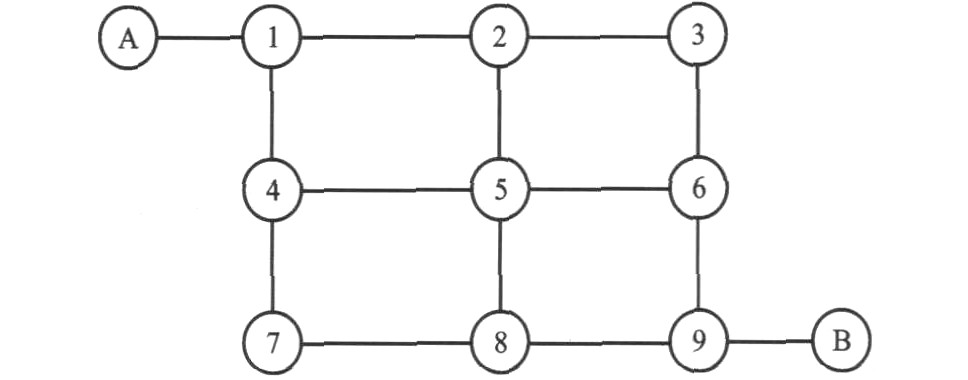Negotiation mechanism model of relationship between residential location and traffic system
-
摘要: 为了检验交通与活动场所之间关系, 建立了房主与移动家庭之间的谈判模型, 得到并证明了城市每个小区每期房价的Nash均衡价格。通过模糊效用估计, 获得候选小区集, 在候选集上采用非协作博弈的混合策略, 提出谈判机制混合策略选择居住地一定存在均衡解, 通过构造函数, 利用Brouwer不动点定理进行证明, 并设计了求解谈判机制模型的算法。算例结果表明: 道路5-8改善后, 通勤目的地5、B的移动家庭选择小区8的家庭数由0变为446, 通勤目的地A、B的移动家庭选择小区9的家庭数由460变化为601。可见, 交通的改善影响居民居住地的选择。Abstract: In order to test the relationship between traffic and activity place, a negotiation model between homeowner and mobile home was proposed, and Nash equilibrium price of each housing price for city district was got and proven. The candidate cell set was received by fuzzy effectiveness estimation, and a mixed strategy of non-cooperative game was adopted in the candidate cell set. The existence of balanced solution was proposed to choose residential location about mixed strategy negotiation mechanism. A function was constructed, and the existence of balanced solution was proven by Brouwer fixed point theorem. An algorithm was proposed to solve the negotiation model. Numerical example result indicates that the mobile home number of choosing district 8 changes from 0 to 446 for 5 and B commute destinations, and the mobile home number of choosing district 9 changes from 460 to 601 for A and B commute destinations after the improvement of road 5-8. So traffic improvement affects residential choice, and the negotiation model is effective.
-
表 1 简单交通路网的静态属性
Table 1. Static attributes of simple traffic network
道路 1-2 2-3 1-4 2-5 3-6 4-5 5-6 4-7 5-8 6-9 7-8 8-9 长度/km 2.900 3.500 3.875 4.000 3.000 3.200 3.000 4.000 3.500 2.720 3.000 3.800 容量/ (veh·h-1) 4 000 3 000 4 000 2 000 3 000 2 000 2 000 2 500 800 4 000 2 500 4 000 自由流速度/ (km·h-1) 60 50 60 30 50 30 30 30 10 60 30 60 表 2 各居住区的静态数据
Table 2. Static data of each residential location
居住区 1 2 3 4 5 6 7 8 9 上期的房价/ (元·d-1) 34 48 28 49 63 48 27 48 34 享乐设施的完备性 0.6 0.8 0.5 0.8 1.0 0.8 0.5 0.8 0.6 家庭数 5 000 5 000 5 000 5 000 20 000 5 000 5 000 5 000 5 000 高收入家庭/% 10 20 10 20 30 20 10 20 10 家庭主要目的地分布 5 500 1 500 1 500 1 500 6 000 1 500 1 500 1 500 500 A 1 500 1 000 500 1 000 2 000 250 500 250 250 B 250 250 500 250 2 000 1 000 500 1 000 1 500 5、A 1 500 1 500 1 000 1 500 4 000 250 1 000 250 250 5、B 250 250 750 250 4 000 1 500 750 1 500 1 500 A、B 1 000 500 750 500 2 000 500 750 500 1 000 表 3 道路平均速度与流量关系
Table 3. Relationship between vehicle average speed and path flow
流量与容量之比 ≤0.3 0.4 0.5 0.6 0.7 0.8 0.9 1.0 1.1 1.2 ≥1.3 平均速度与自由流速度之比 1 34/35 31/35 24/35 19/35 14/35 9/35 4/35 3/35 2/35 0 表 4 移动家庭选择居住地的结果
Table 4. Result of residence choice for mobile homes
家庭目的地 道路5-8改善前移动家庭选择 道路5-8改善后移动家庭选择 5 A B 5、A 5、B A、B 5 A B 5、A 5、B A、B 居住区 1 0 1 450 0 744 0 379 0 1 450 0 755 0 464 2 0 0 0 851 0 0 0 0 0 865 0 0 3 0 0 0 0 0 0 0 0 0 0 0 0 4 0 0 0 0 0 0 0 0 0 0 0 0 5 3 200 0 0 655 641 0 3 200 0 0 630 556 0 6 0 0 0 0 726 333 0 0 0 0 538 435 7 0 0 0 0 0 0 0 0 0 0 0 0 8 0 0 0 0 0 328 0 0 0 0 446 0 9 0 0 1 450 0 783 460 0 0 1 450 0 610 601 -
[1] CHANGJ S, MACKETT R L. Abi-level model of the relationship between transport and residential location[J]. Transportation Research Part B: Methodological, 2006, 40 (2): 123-146. doi: 10.1016/j.trb.2005.02.002 [2] BRAVO M, BRICENO L, COMI NETTI R, et al. An integrated behavioral model of theland-use andtransport systemswith network congestion and location externalities[J]. Transportation Research Part B: Methodological, 2010, 44 (4): 584-596. doi: 10.1016/j.trb.2009.08.002 [3] PINJARI A R, BHAT C R, HENSHER D A. Residential self-selection effects in an activity ti me-use behavior model[J]. Transportation Research Part B: Methodological, 2009, 43 (7): 729-748. doi: 10.1016/j.trb.2009.02.002 [4] VEGA A, REYNOLDS-FEIGHAN A. A methodological framework for the study of residential location and travel-to-work mode choice under central and suburban employment destination patterns[J]. Transportation Research Part A: Policy and Practice, 2009, 43 (4): 401-419. doi: 10.1016/j.tra.2008.11.011 [5] MOKHTARI AN P L, CAO Xin-yu. Examining the impacts of residential self-selection on travel behavior: a focus onmethodologies[J]. Transportation Research Part B: Method-ological, 2008, 42 (3): 204-228. doi: 10.1016/j.trb.2007.07.006 [6] MARTI NEZ F J, HENRI QUEZ R. A random bidding andsupply land use equilibrium model[J]. Transportation Research Part B: Methodological, 2007, 41 (6): 632-651. doi: 10.1016/j.trb.2006.08.003 [7] EARNHART D. Combining revealed and stated data to examine housing decisions using discrete choice analysis[J]. Journal of Urban Economics, 2002, 51 (1): 143-169. doi: 10.1006/juec.2001.2241 [8] 陆化普, 王建伟, 袁虹. 基于交通效率的大城市合理土地利用形态研究[J]. 中国公路学报, 2005, 18 (3): 109-113. https://www.cnki.com.cn/Article/CJFDTOTAL-ZGGL200503023.htmLU Hua-pu, WANG Jian-wei, YUAN Hong. Study of opti malurban land-use pattern based on transportation efficiency[J]. China Journal of Highway and Transport, 2005, 18 (3): 109-113. (in Chinese) https://www.cnki.com.cn/Article/CJFDTOTAL-ZGGL200503023.htm [9] 李晓燕, 陈红. 城市生态交通规划的理论框架[J]. 长安大学学报: 自然科学版, 2006, 26 (1): 79-82. https://www.cnki.com.cn/Article/CJFDTOTAL-XAGL200601017.htmLI Xiao-yan, CHEN Hong. Urban eco-transportation plan-ning theory[J]. Journal of Chang an University: NaturalScience Edition, 2006, 26 (1): 79-82. (in Chinese) https://www.cnki.com.cn/Article/CJFDTOTAL-XAGL200601017.htm [10] 裴玉龙, 徐慧智. 基于城市区位势能的路网密度规划方法[J]. 中国公路学报, 2007, 20 (3): 81-85. https://www.cnki.com.cn/Article/CJFDTOTAL-ZGGL200703014.htmPEI Yu-long, XU Hui-zhi. Planning method of road net work density based on urban area position potential energy[J]. China Journal of Highway and Transport, 2007, 20 (3): 81-85. (in Chinese) https://www.cnki.com.cn/Article/CJFDTOTAL-ZGGL200703014.htm [11] 王花兰, 周伟, 王元庆. 交通发展对中心城市空间扩展的影响[J]. 长安大学学报: 自然科学版, 2007, 27 (4): 79-83. https://www.cnki.com.cn/Article/CJFDTOTAL-XAGL200704017.htmWANG Hua-lan, ZHOU Wei, WANG Yuan-qing. Influenceof transportation between central city and satellite city onurban spatial expansion[J]. Journal of Chang an University: Natural Science Edition, 2007, 27 (4): 79-83. (in Chinese) https://www.cnki.com.cn/Article/CJFDTOTAL-XAGL200704017.htm [12] 董小林, 宋赪, 周晶, 等. 区域环境经济指标体系的构建[J]. 长安大学学报: 自然科学版, 2008, 28 (1): 87-91. https://www.cnki.com.cn/Article/CJFDTOTAL-XAGL200801018.htmDONG Xiao-lin, SONG Cheng, ZHOUJing, et al. Development of district environment economics indicator system[J]. Journal of Chang an University: Natural Science Edition, 2008, 28 (1): 87-91. (in Chinese) https://www.cnki.com.cn/Article/CJFDTOTAL-XAGL200801018.htm [13] 周伟, 李媛媛. 中国城市公共交通建设策略的理论与方法[J]. 长安大学学报: 自然科学版, 2007, 27 (4): 65-69. https://www.cnki.com.cn/Article/CJFDTOTAL-XAGL200704014.htmZHOU Wei, LI Yuan-yuan. Developingtheory and method of urban public traffic in China[J]. Journal of Chang anUniversity: Natural Science Edition, 2007, 27 (4): 65-69. (in Chinese) https://www.cnki.com.cn/Article/CJFDTOTAL-XAGL200704014.htm [14] 陈宽民, 樊大可, 马超群. 基于客流集散点的城市轨道交通线网规模计算[J]. 长安大学学报: 自然科学版, 2009, 29 (6): 78-81. https://www.cnki.com.cn/Article/CJFDTOTAL-XAGL200906018.htmCHEN Kuan-min, FAN Da-ke, MA Chao-qun. Calculation of urban rail transit network scale based on passenger distri-buting centers[J]. Journal of Chang an University: NaturalScience Edition, 2009, 29 (6): 78-81. (in Chinese) https://www.cnki.com.cn/Article/CJFDTOTAL-XAGL200906018.htm [15] MARKOSE S, ALENTORN A, KOESRI NDARTOTO D, et al. A smart market for passenger road transport (SMPRT) congestion: an application of computational mech-anismdesign[J]. Journal of Economic Dynamics and Control, 2007, 31 (6): 2001-2032. -





 下载:
下载:


